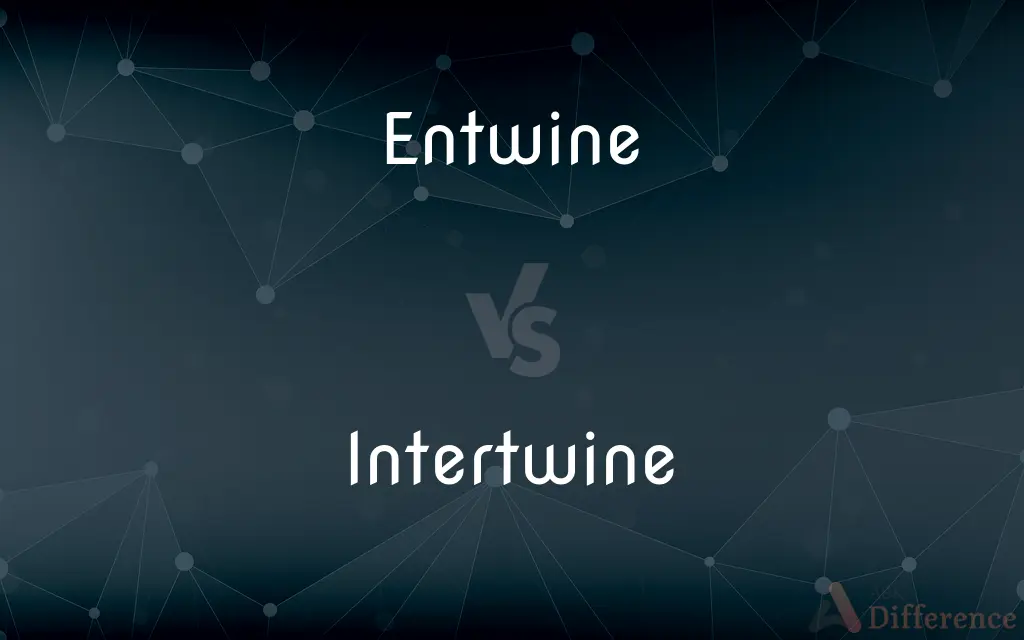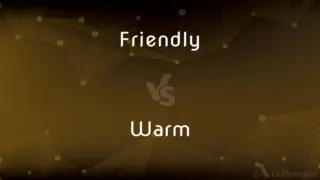Entwine vs. Intertwine — What's the Difference?
Edited by Tayyaba Rehman — By Urooj Arif — Updated on March 7, 2024
Entwine refers to the action of twisting together, while intertwine emphasizes a more complex intermingling or weaving together.

Difference Between Entwine and Intertwine
Table of Contents
ADVERTISEMENT
Key Differences
Entwine typically implies the action of winding or twisting one thing around another, suggesting a simpler form of connection or binding. For example, vines can entwine around a trellis, symbolizing a straightforward wrapping or coiling motion. On the other hand, intertwine often denotes a more complex or intricate blending or intermingling of two or more elements. It suggests a deeper, more integrated merging, as in the intertwining of destinies or stories, where elements are not just wrapped around each other but are interwoven in a way that makes them inseparable.
When thinking about the physical act of entwining, it often involves two elements being twisted together, which might still be distinguishable from one another. This could be as simple as threads entwined to form a braid, where each component maintains its identity within the combined form. Intertwining, however, brings to mind a more complex interaction, such as the roots of different plants growing together in such a way that they cannot be easily separated. Here, the emphasis is on a deeper level of connection and interdependency.
The usage context for entwine and intertwine can also differ. Entwine is often used in more literal or physical contexts, referring to tangible objects being wrapped or coiled around each other. In contrast, intertwine is frequently employed in both literal and figurative language, able to describe the mingling of abstract concepts such as ideas, narratives, or relationships as well as physical entities.
In literature and art, the difference between entwine and intertwine can be seen in the portrayal of relationships and themes. Entwine might be used to describe a relationship where two individuals are connected yet maintain their separate identities, akin to vines wrapped around a support. Intertwine, conversely, could describe a relationship where individuals or themes are so deeply connected that their identities or stories become part of a single narrative, unable to be untangled.
Both terms suggest a form of union, but the nature of the union differs. Entwine implies a simpler, perhaps more superficial connection, while intertwine suggests a deeper, more intrinsic intermingling. This difference in depth and complexity can be crucial in understanding the relationship between the elements in question, whether they are physical objects, concepts, or living entities.
ADVERTISEMENT
Comparison Chart
Definition
To twist together or around something.
To connect or link (two or more things) closely.
Complexity
Suggests a simpler form of twisting or coiling.
Implies a more complex or intricate weaving together.
Physical vs. Abstract
Often used in physical or tangible contexts.
Can be used in both physical and figurative contexts.
Level of Integration
Elements may remain more distinct within the union.
Elements are more deeply merged or interwoven.
Example Usage
Vines can entwine around a pole.
Stories can intertwine, merging themes or characters.
Compare with Definitions
Entwine
To wrap or coil around something.
The snake entwined itself around the branch.
Intertwine
To connect or relate closely.
The documentary intertwines personal stories with historical events.
Entwine
To connect or associate closely.
Their lives became entwined after years of friendship.
Intertwine
To interweave or blend intricately.
The novel intertwines reality with fantasy.
Entwine
To twist or wind together.
She entwined the flowers into a beautiful wreath.
Intertwine
To twine together; to become very closely involved.
Their fates were intertwined from the start.
Entwine
To become twisted or interlocked.
The yarn colors entwined to create a stunning pattern.
Intertwine
To mix or mingle comprehensively.
Cultures intertwine in the global city, creating a unique environment.
Entwine
To involve or entangle.
The plot entwines multiple characters’ stories.
Intertwine
To involve or incorporate deeply.
The artist’s work intertwines traditional and modern elements.
Entwine
Entwine was a Finnish gothic metal band from Lahti, Finland.
Intertwine
To join or become joined by twining together.
Entwine
To twine around or together
The ivy entwined the column.
Intertwine
(transitive) To twine something together.
Entwine
To twine or twist together.
Intertwine
(intransitive) To become twined together.
Entwine
To twist or twine around something (or one another).
Intertwine
To unite by twining one with another; to entangle; to interlace.
Entwine
To twine, twist, or wreathe together or round.
Entwined in duskier wreaths her braided locks.
Thy glorious household stuff did me entwine.
Intertwine
To be twined or twisted together; to become mutually involved or enfolded.
Entwine
To be twisted or twined.
With whose imperial laurels might entwine no cypress.
Intertwine
The act of intertwining, or the state of being intertwined.
Entwine
Tie or link together
Intertwine
Spin or twist together so as to form a cord;
Intertwine the ribbons
Twine the threads into a rope
Entwine
Spin or twist together so as to form a cord;
Intertwine the ribbons
Twine the threads into a rope
Intertwine
Make lacework by knotting or looping
Intertwine
Make a loop in;
Loop a rope
Common Curiosities
What does it mean to entwine?
To entwine means to twist or wrap one thing around another, often implying a simpler form of connection.
What does intertwine signify?
Intertwine signifies a deeper, more complex mingling or weaving together of elements, either physically or abstractly.
Can the terms entwine and intertwine be used interchangeably?
While similar, they are not always interchangeable, as intertwine often suggests a greater complexity or depth of connection.
How do entwine and intertwine differ in literature?
In literature, entwine might describe physical connections or simpler relationships, while intertwine often denotes deeply integrated relationships or themes.
Does intertwine imply a permanent connection?
While not necessarily permanent, intertwine does suggest a deeper level of connection that might be more challenging to separate.
Can a story entwine or should it always intertwine?
A story can do both, depending on the depth of connection between its elements; intertwine is used for more complex interconnections.
What is an example of entwining?
An example of entwining is vines wrapping around a trellis.
Can intertwine be used in a negative context?
Yes, intertwine can be used in negative contexts to describe situations where elements are complicatedly connected in undesirable ways.
Is entwine or intertwine more appropriate for describing relationships?
Intertwine is often more appropriate for describing complex or deeply connected relationships.
Is intertwine always figurative?
No, intertwine can be used both figuratively and literally, but it often carries a figurative sense when discussing abstract concepts.
Is entwine more physical than intertwine?
Entwine is often used in more physical contexts, whereas intertwine can apply to both tangible and intangible elements.
Can objects as well as concepts be intertwined?
Yes, both objects and concepts, such as ideas or stories, can be intertwined, suggesting a close or complex connection.
What is an example of intertwining?
An example of intertwining is the way personal and political narratives are woven together in a novel.
How does the context influence the choice between entwine and intertwine?
The context influences the choice based on the depth and complexity of the connection being described; intertwine is chosen for more intricate or significant connections.
How does the complexity of entwine compare to intertwine?
Entwine implies a less complex form of connection than intertwine, which denotes a more intricate weaving together.
Share Your Discovery

Previous Comparison
Friendly vs. Warm
Next Comparison
Bonny vs. BlitheAuthor Spotlight
Written by
Urooj ArifUrooj is a skilled content writer at Ask Difference, known for her exceptional ability to simplify complex topics into engaging and informative content. With a passion for research and a flair for clear, concise writing, she consistently delivers articles that resonate with our diverse audience.
Edited by
Tayyaba RehmanTayyaba Rehman is a distinguished writer, currently serving as a primary contributor to askdifference.com. As a researcher in semantics and etymology, Tayyaba's passion for the complexity of languages and their distinctions has found a perfect home on the platform. Tayyaba delves into the intricacies of language, distinguishing between commonly confused words and phrases, thereby providing clarity for readers worldwide.















































